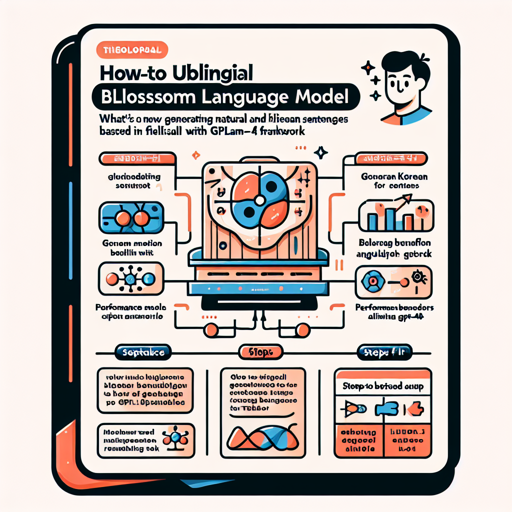The Bllossom language model is a sophisticated Korean-English bilingual model based on the popular open-source LLama3.1 framework. In this guide, we will walk you through the installation, setup, and example usage of the Bllossom-405B model, while providing troubleshooting tips along the way. Let’s delve into the world of bilingual AI!
What’s New with Bllossom-405B?
As of recent updates, the Bllossom team has announced enhancements in the Korean performance by 5-10% compared to its previous version. Here’s a quick overview of its features:
- Maintains English performance while significantly improving Korean output.
- Generates natural and friendly Korean sentences.
- Performance benchmarks closely align with GPT-4.
Setting Up the Bllossom Model
To begin leveraging the Bllossom-405B model, you will need to follow these steps:
Step 1: Install Required Dependencies
pip install torch transformers==4.40.0 accelerateStep 2: Import the Model and Initialize It
Here’s where the fun begins! Imagine assembling a powerful machine at a factory; this is how you’ll set up the pipeline for generating text:
import transformers
import torch
model_id = "Bllossom/llama-3.1-Korean-Bllossom-405B"
pipeline = transformers.pipeline(
"text-generation",
model=model_id,
model_kwargs={"torch_dtype": torch.bfloat16},
device_map="auto",
)
pipeline.model.eval()
Step 3: Generating Text
To generate responses, think of it as giving your assembly line a new order every time you want to produce a different product. In our context, it’s about creating responses based on user input.
PROMPT = '''You are a helpful AI assistant. Please answer the user's questions kindly. 당신은 유능한 AI 어시스턴트 입니다. 사용자의 질문에 대해 친절하게 답변해주세요.'''
instruction = "서울의 유명한 관광 코스를 만들어줄래?"
messages = [
{"role": "system", "content": f"{PROMPT}"},
{"role": "user", "content": f"{instruction}"}
]
prompt = pipeline.tokenizer.apply_chat_template(
messages,
tokenize=False,
add_generation_prompt=True
)
terminators = [
pipeline.tokenizer.eos_token_id,
pipeline.tokenizer.convert_tokens_to_ids("<|eot_id|>")
]
outputs = pipeline(
prompt,
max_new_tokens=2048,
eos_token_id=terminators,
do_sample=True,
temperature=0.6,
top_p=0.9
)
print(outputs[0]["generated_text"][len(prompt):])
With these steps, your Bllossom assistant will provide you with engaging and informative responses!
Troubleshooting
If you encounter any issues during installation or usage, consider the following troubleshooting steps:
- Ensure Dependencies Are Installed: Double-check that all necessary libraries are installed correctly and are compatible with your environment.
- Resource Management: If you’re running into resource limitations, consider using the quantized model with less GPU power. Check the quantized model for more efficient performance.
- Model Adaptation: Try testing with different model parameters (like temperature and top_p) to see how they affect the output quality.
- For more insights, updates, or to collaborate on AI development projects, stay connected with fxis.ai.
Conclusion
With Bllossom-405B, you’ve unlocked a powerful tool for bilingual text generation that can aid in various applications—from chatbot integrations to content generation. At fxis.ai, we believe that such advancements are crucial for the future of AI, as they enable more comprehensive and effective solutions. Our team is continually exploring new methodologies to push the envelope in artificial intelligence, ensuring that our clients benefit from the latest technological innovations.
Embrace the capabilities of Bllossom and enjoy the journey of exploring bilingual AI!

